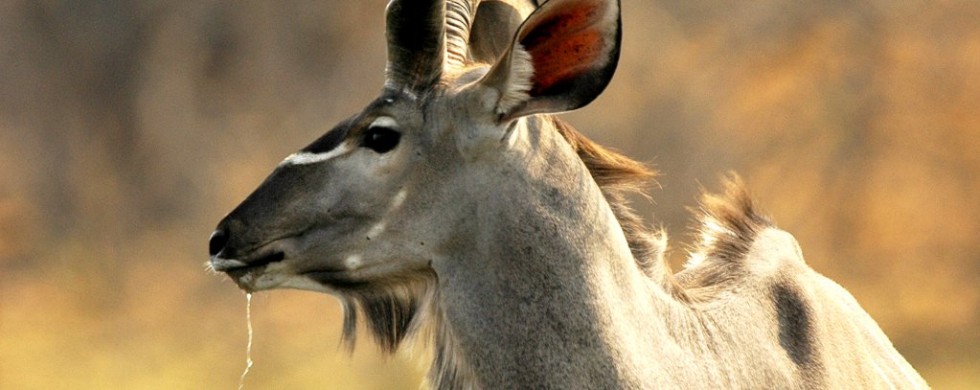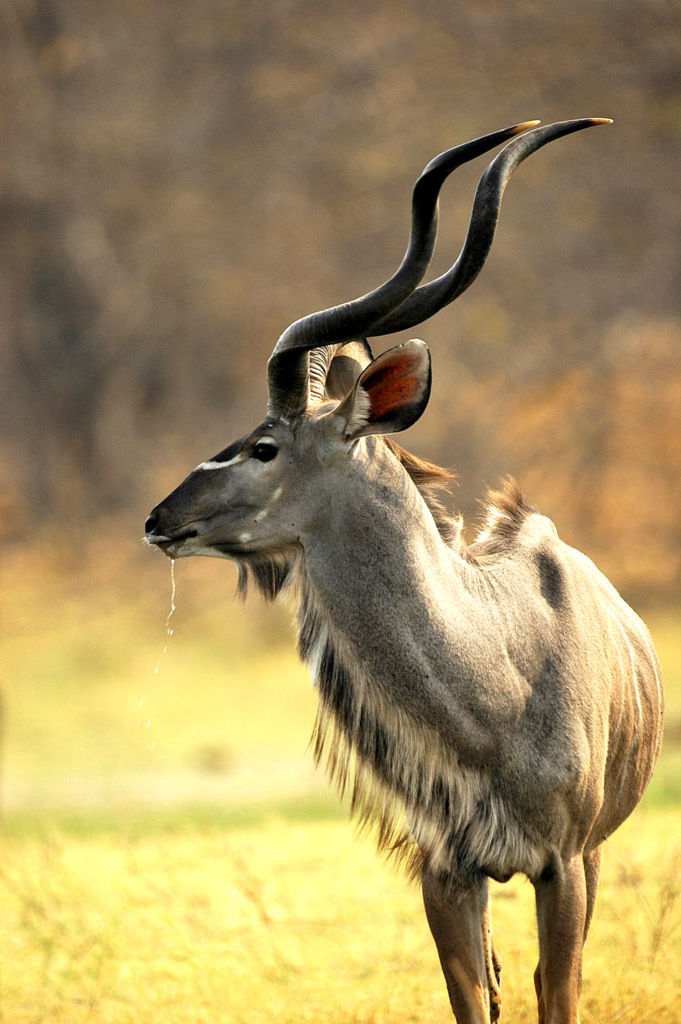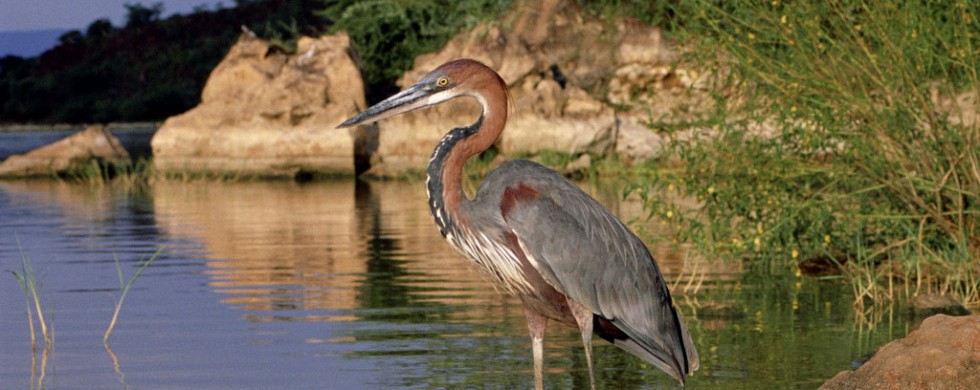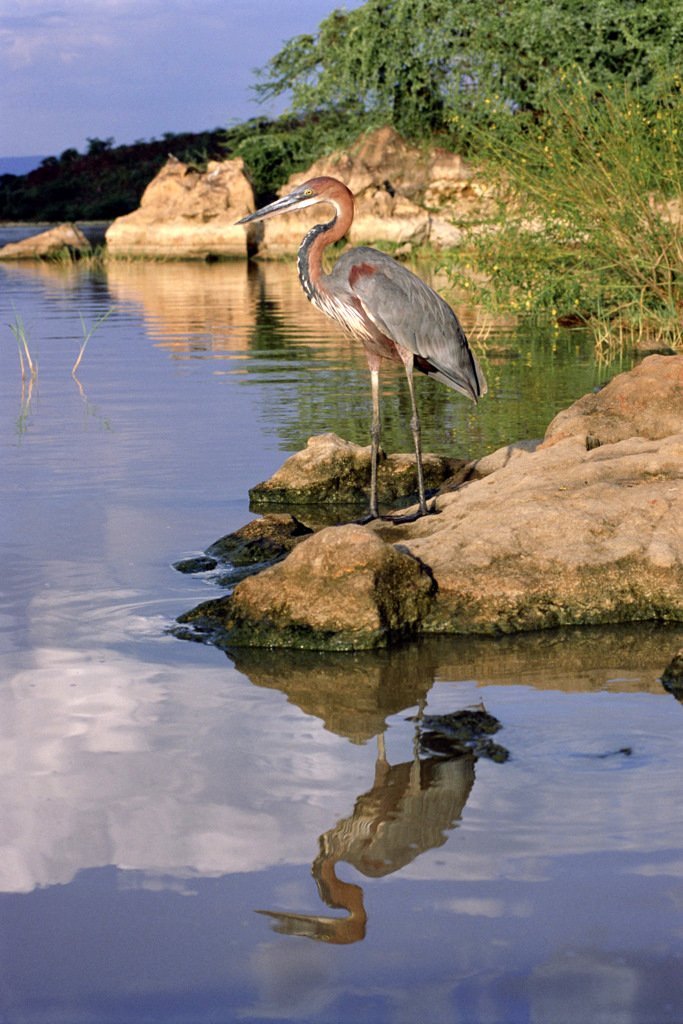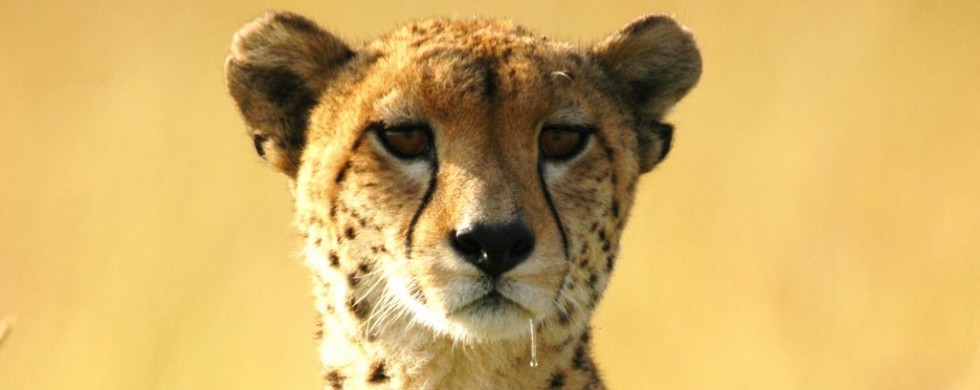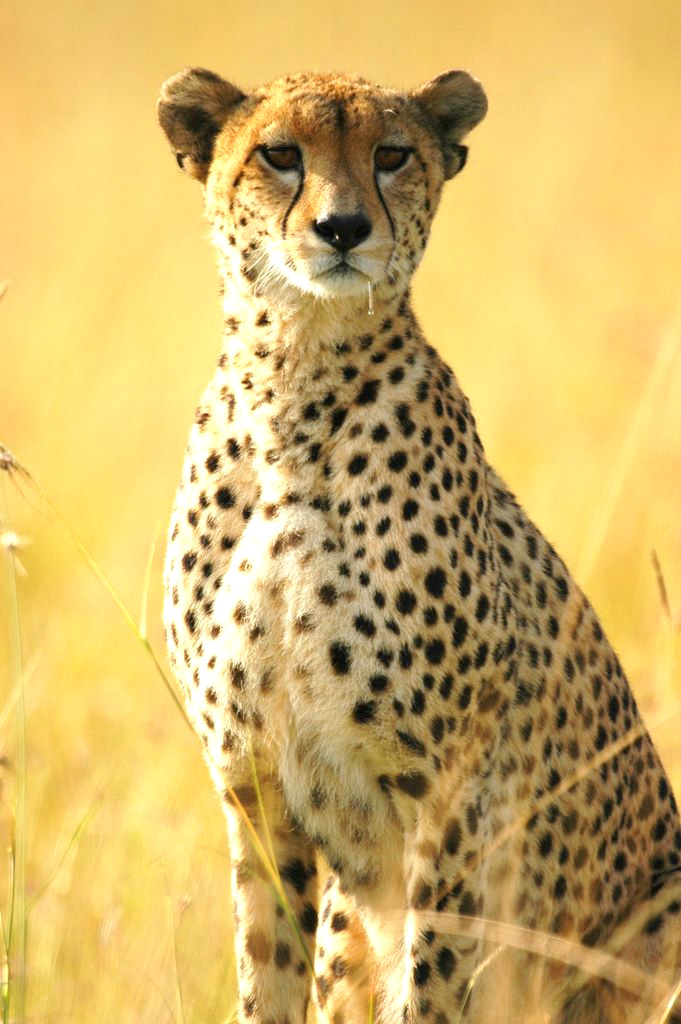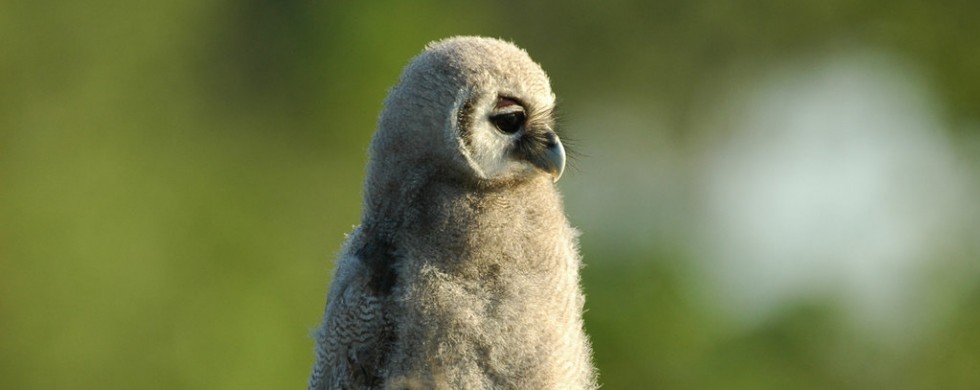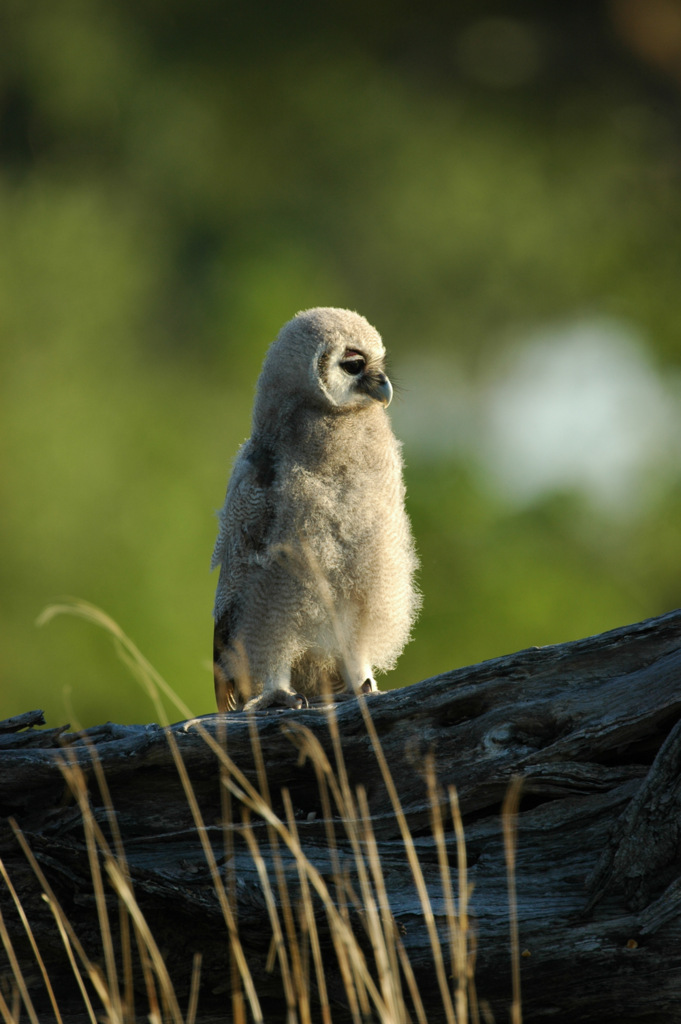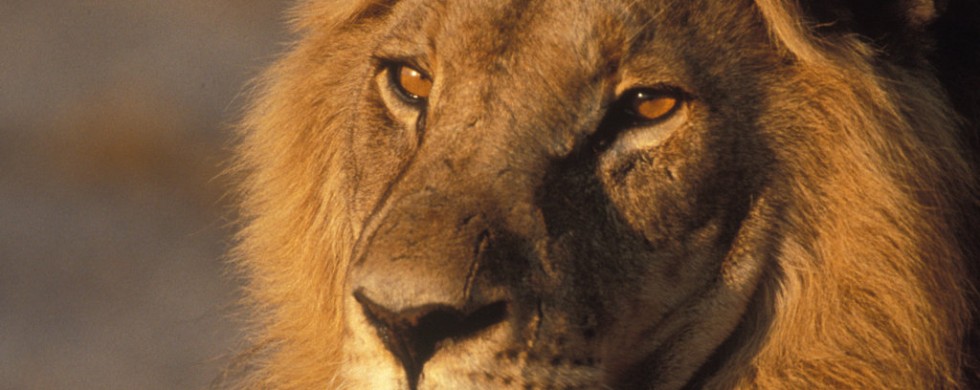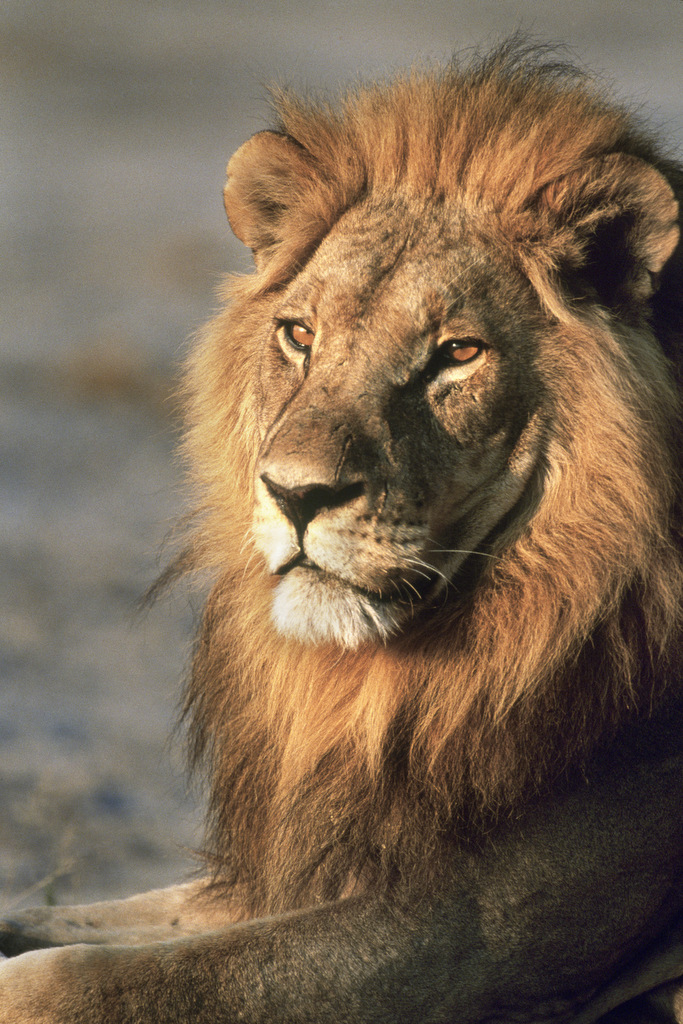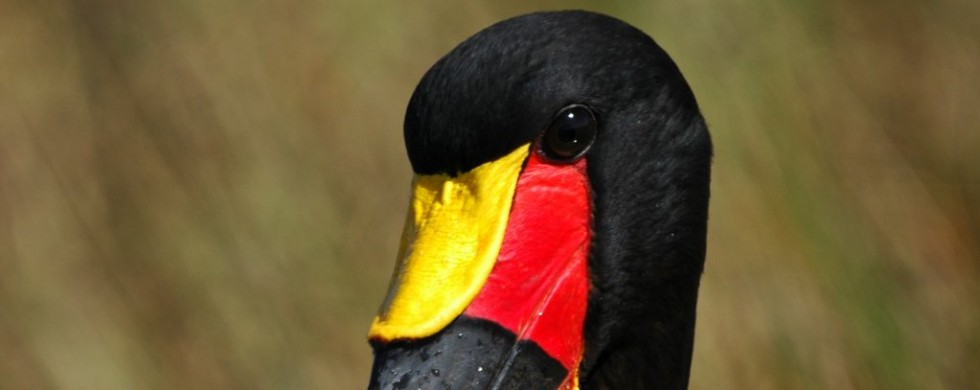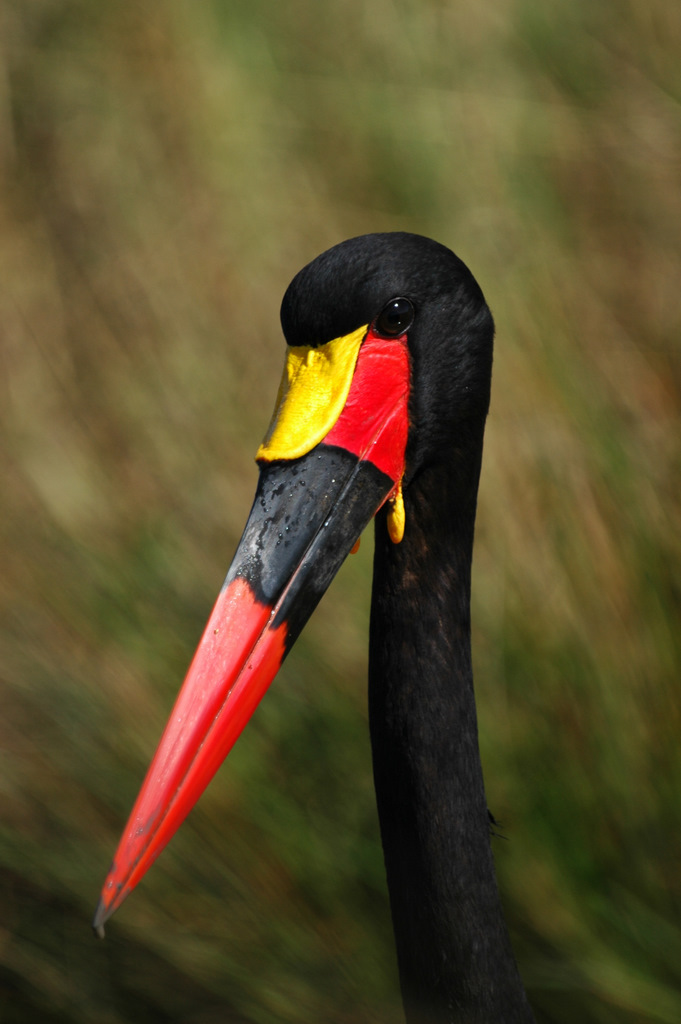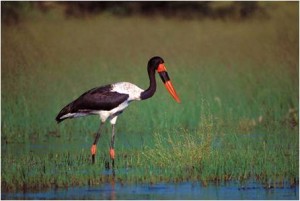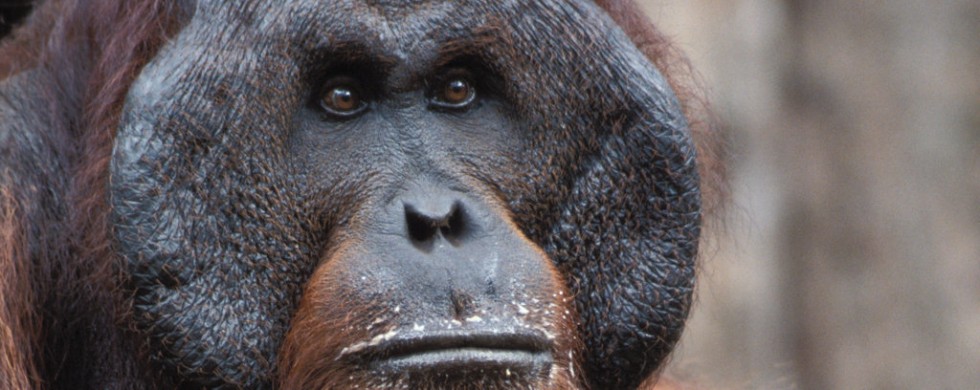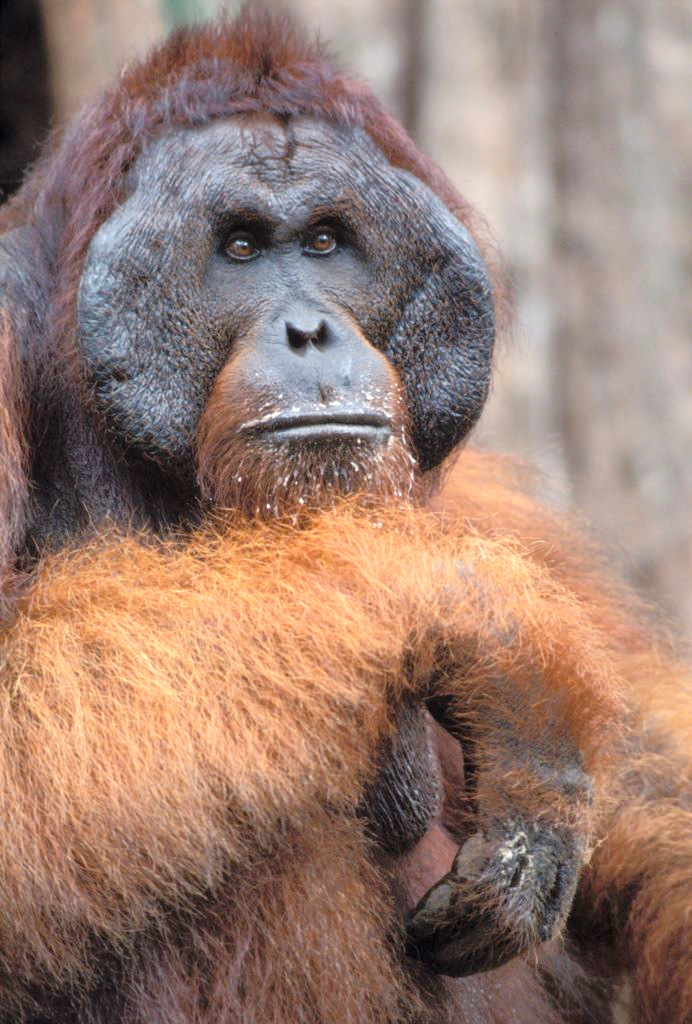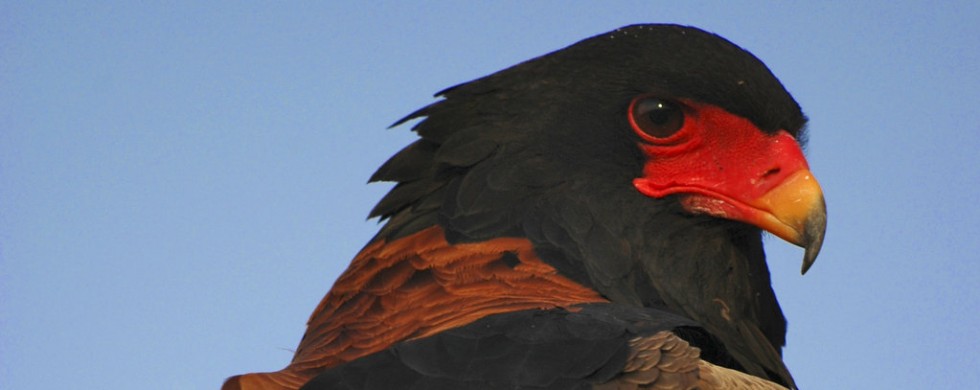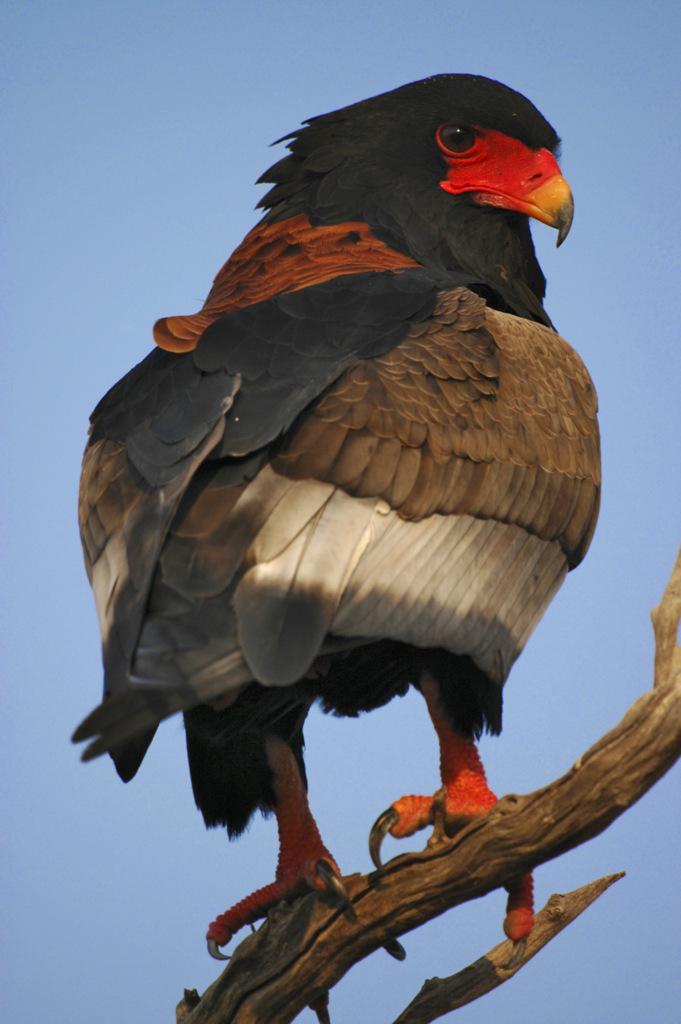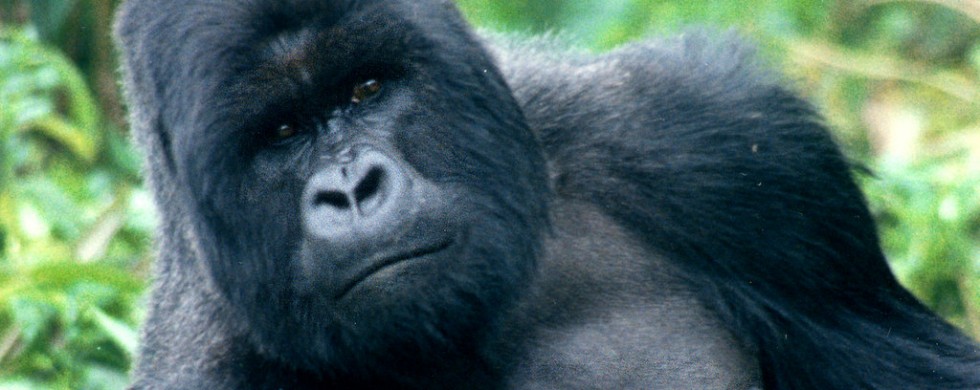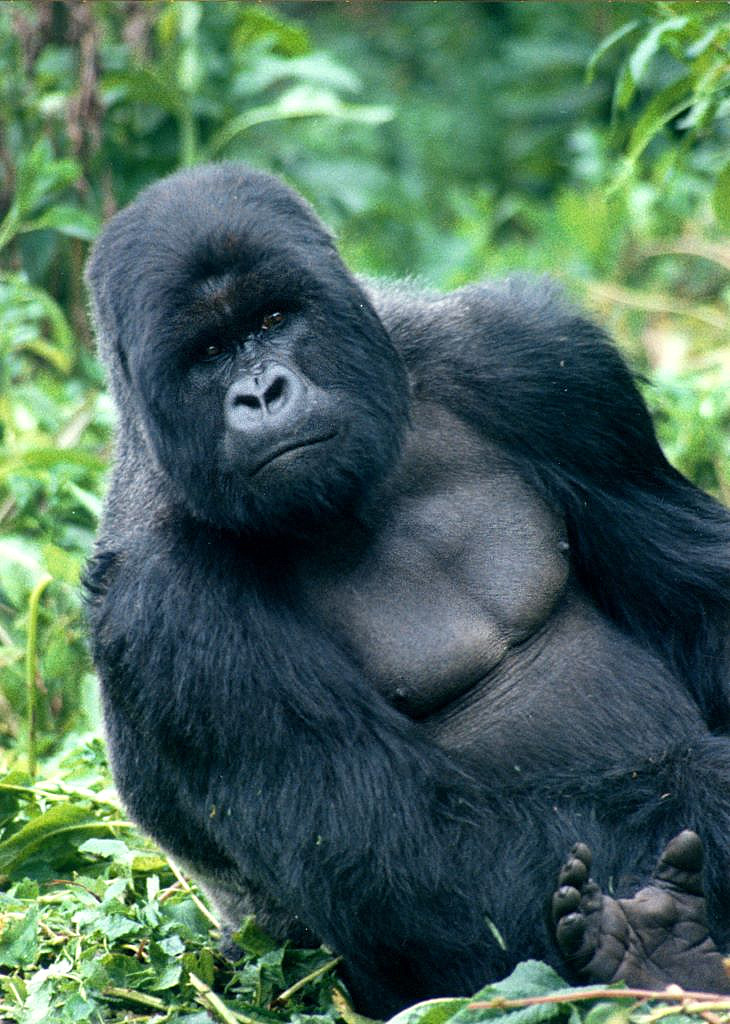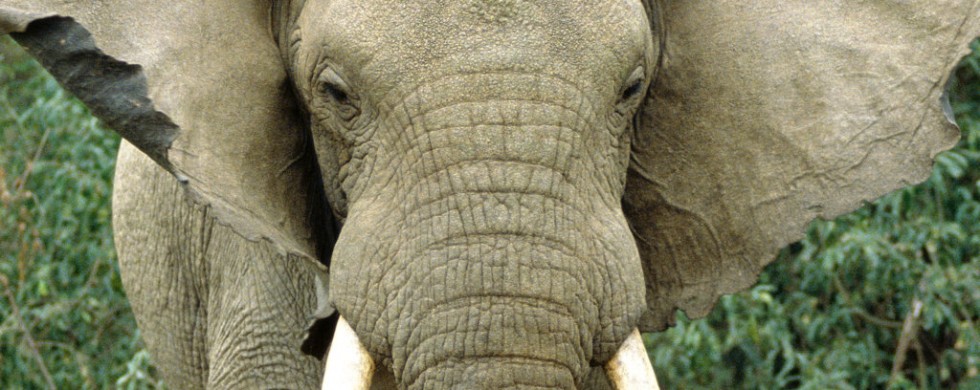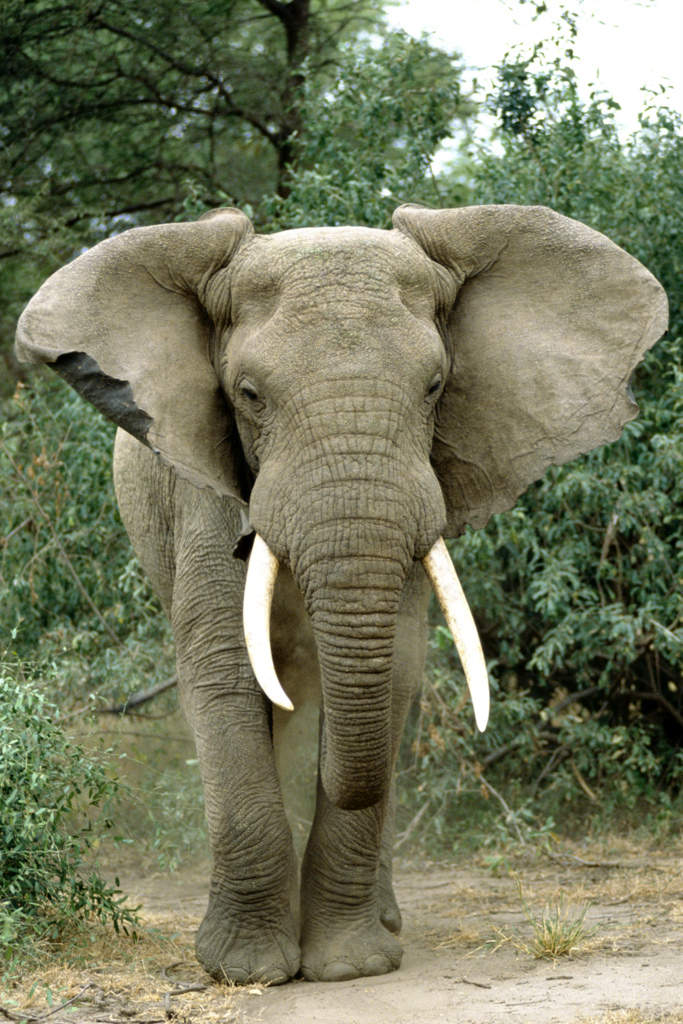15
Shot of the Month – April 2010
What can weigh up to 600 pounds and has a mane?
No, try again. The male lion only weighs up to 400 pounds.
The picture is a big clue. It is the Greater Kudu.
Believe it or not, these massive antelopes are only the 2nd largest antelopes in the world. For those of you keeping score at home the largest antelope is the Eland, weighing in at up to 1,500 pounds. But that is a story for another month.
Greater Kudu can be found across a wide range of Africa. In the east, they live in Ethiopia, Tanzania, Eritrea, and Kenya. In the south, they live in Zambia, Angola, Namibia, Zimbabwe, South Africa, and in Botswana, where this photo was taken.
Kudus prefer to live in thick, wooded areas, rocky hillsides, dry river beds, and areas with lots of water. Turns out that kudu are vulnerable on the open plains as they do not run very fast and they do not have much stamina — ergo with nowhere to hide they can be easily run down by lions, leopards, and wild dogs. However, among the thick bush kudu have a better chance of success. Despite their size, kudu are excellent jumpers and a male can easily leap 8 feet or more (Picture a 600 lb antelope jumping clean over your head with a couple of feet to spare!) When pursued they simply leap over rocks and bushes that predators have a hard time navigating. And for the kudu, the best defense is a good offense, of sorts. Amongst the thick vegetation, their colorations and markings make them very difficult to see – so if they remain perfectly still they can often go undetected by carnivores on the prowl.
Despite their wide range kudu numbers are declining. Much of their habitat is disappearing as humans cut down the forests to make farmland. Hunting is also a big problem as trophy hunters prize those amazing cork-screw horns that are found only on males. At full maturity, the horns make a complete 2 ½ twist.
Alas, if humanity continues its relentless encroachment the kudu will soon have no place left to hide, and then, ironically, we will truly never see them again.
15
Shot of the Month – February 2010
Ok, you guessed it, this month we are going to talk about cheetahs. This is a glamour shot of a healthy cheetah that I found on the plains of Kenya, Africa. The allure is a bit dampened by that bit of drool, uh, just there, yeah, there on the right. At the time of this shot the cheetah and I were surrounded by thousands of zebra –perhaps this fellow was contemplating the dining bonanza before us.
Attacking an adult zebra is a daydream at best. Adult zebra can weigh from 450 to 1,000 lbs – far outside the weight class of our speedy cat. A full-grown cheetah weighs from 80 to 140 lbs and focuses on smaller prey that usually weighs less than 90 lbs often preferring Thomson’s Gazelle, Grant’s Gazelle, springbok, or the Impala. On a good day, a cheetah might go after a baby zebra or wildebeest.
No creature in the world can run as fast – cheetahs can reach speeds of 75 mph in 3 seconds flat and can cover 24 feet in a single stride. That means a cheetah can accelerate faster than any Ferrari, Porsche, or Lamborghini made today.
Virtually every aspect of the cheetah’s body has been transformed to maximize speed. They have a slender, long-legged torso very similar to that of a greyhound dog. They have semi-retractable claws – claws that cannot be fully withdrawn. The claws are therefore always in contact with the ground ensuring excellent traction acting much like a good set of track cleats. Cheetahs have large nostrils to improve oxygen intake and they have an enlarged heart, liver, and lungs to efficiently circulate oxygen throughout the body. They have small heads to lower wind resistance. An unusually flexible spine acts like a giant spring that can produce explosive surges of speed and long strides. Black “tear marks” that run from the inside corner of each eye down the side of the nose help reduce glare from the sun and improve vision (think football players with black makeup on their cheeks). Finally, cheetahs have especially long tails which act like rudders that enable them to make exceptionally sharp turns and outflank fleeing prey.
Basically, a cheetah is a supercar on paws. But so many words…. as they say, a picture is worth a thousand of ‘em…
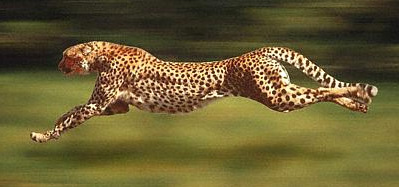 (Source)
(Source)
Now. That’s. Fast.
Until next month…:-)
15
Shot of the Month – January 2010
After only a few minutes into our morning game drive, we drove around a sharp corner and as we cleared the bend my guide slammed on the brakes. In front of us, we were startled to find a young, seemingly mesmerized owl standing on a large log.
It was like a scene out of a fairy tale. The air was cool and the morning air fresh, but still. The owl’s fuzzy down feathers were softly lit as the sun just began to rise over the horizon. The fledgling stared forward as if in deep thought or reflection.
While obviously still young, this owl was BIG. After a moment of taking this all in the questions began to cascade through my brain. What kind of owl is so big yet still so young? Why is he on a log? Why on the ground? Where are the parents? Why is he just sitting there?
I broadened my field of view to see if I could find any clues to this mystery. After a few seconds of scanning, I found two adult Giant Eagle Owls (that explains the size, they are the largest owls in Africa) high up in a nearby tree peering down at their offspring. The scene started to make sense.
This was Junior’s first flight!
He had soared down from the nest and was now on the ground trying to figure out what to do next. Our fledgling finally broke free from his meditation and turned to look up at his parents.
He opened his wings and hesitantly leapt into the air. I was startled again, this time by the width of his wing span. This was a large bird but the wing span seemed exaggerated beyond reason compared to his body size. Regardless, the motion of the wings was absolutely silent. His first effort only garnered about 6 feet and then he landed (read “crashed”) onto the trunk of a nearby tree. In parrot-like fashion, he used his beak to help climb up the tree to a higher branch. He then leapt into the air again and gained a few more feet before “landing” a bit higher in another nearby tree. He slowly zigzagged his way up to the tree where his proud parents were waiting.
What an extraordinary experience. One of my safari favorites.
A few insights from this encounter to help start the New Year:
- Get out and explore the world. (You never know what will be around the next corner)
- Wake up early. It is a magical time. (painful, yes, but magical)
- Make time to reflect (before you leap)
- Set high goals. Take small steps to reach them
- Expect a few crashes along the way, but don’t let them stop you
Happy New Year!
15
Shot of the Month – December 2009
This month some celebrate the birth of the King of Kings. One Christmas story tells how three wise men were aided by a bright star that led them to the new King.
While less transcendent, three men (also less wise) were aided in finding the king of the animal world allowing me to capture this regal portrait of the male lion.
Our journey began on a crisp morning in Botswana as I, a visiting friend, and our guide/driver (the three wise-ish men) left camp in our Toyota Landcruiser (all out of camels) in search of royalty. After a few minutes on the trail, we heard the roar of a lion. We drove in that direction and found a young male lion walking with purpose. The young lion was agitated; he was clearly trying to find his missing pride.
Finally, after 20 minutes of plaintive calls and walking hither and thither, we heard a bellow off in the distance. Our young prince looked hopeful and called again and walked briskly in the direction of the deep roar. After another 10 minutes of the lion equivalent of “Marco Polo” the young lion led us to the magnificent black-manned lion in this photo. He was with a female and it was clear they were a mating couple. Their reunion was full of head bumps and body rubs. The animal lover in me reveled in the moment and the photographer in me went giddy as the sun finally rose above the horizon and an orange beam of light basked the lion in this heavenly glow. Click….sigh.
During this holiday season, I hope that you will likewise manage to reconnect with those dear to you and revel in the simple pleasure of being together. A warm head bump to you all.
(Speaking of great reunions. In 1969 two Australians living in the center of London bought a lion cub at Harrods department store. After a few months, it became clear that Christian, the lion, was becoming too big to live in the city. Rather than put him in a zoo they persuaded conservationist George Adamson (remember “Born Free”?) in Kenya to take Christian and teach him how to live in the wild. A year later the men returned to Africa to see how their now wild lion cub was doing. See the amazing reunion here )
15
Shot of the Month – November 2009
This month I offer this glam headshot of a Yellow Saddle-Billed Stork (SBS). Such a close-up of this bird is a rarity – they are solitary birds that don’t hang out in flocks and generally don’t like company. Most of my views of these storks have been at great distances and even then they often immediately turn and start walking in the opposite direction. As a photographer, this can be extremely frustrating given how stunningly they are adorned.
This stork is the sub-Saharan counterpart to Sesame’s Big Bird – they are the tallest stork in Africa and males can reach 5 feet in height and have a 9-foot wingspan. And the colorations! Where to begin? First, we have that massive brilliant red and black bill that is a great weapon for spearing fish, frogs, crabs, water beetles, etc. On top of the bill is a bright yellow plate that resembles the saddle you might find on a horse. Next, his face, neck, wings, and tail feathers are black while his back and chest are white. Finally, his legs are black but they are offset by reddish colored joints.
In this photo you can get a better view of his wild outfit:
This guy does not “blend.” (Any “My Cousin Vinny” fans out there?)
The male, as shown in the portrait, can be significantly larger than the female and has dark eyes and a bright yellow waddle on each side of the bill. Females have yellow eyes and no waddle. These storks are believed to mate for life and apparently have no arguments – SBSs have no muscles in their voice box so they are silent. Mating couples can communicate, however, by rattling their bills together.
It seems counterintuitive that such a solitary, shy, silent bird would be decked out in such a brilliant, ostensibly boastful display that demands notice and attention.
Another mystery of Mother Nature…
15
Shot of the Month – October 2009
The harbinger of success for some is acceptance into an exclusive club. Perhaps it is membership at an expensive golf course or getting the nod from the man with no neck to jump the line at that by-invitation-only nightclub.
Based on a news story I read in 2002 about devastating wildfires in Borneo I decided to fly to Borneo to try and see orangutans in the wild. Successful in my venture I became a member of a very exclusive club indeed. There is no salary quota, or star power fame required to join the club, simply the effort needed to journey up the Sekonyer River in the Tanjung Puting National Park in southern Borneo.
So what makes this club so special? Well, I may be among the last small group of humans to ever see an orangutan outside of a zoo. Orangutan means “man of the jungle” in the Malay language. In the last 20 years, we have destroyed 80% of all the forests they live in. On the island of Sumatra, the orangutan population has dropped 86% from what it was just 100 years ago and they are listed as “critically endangered.” The next status after critically endangered is “extinct.”
No jungle, no orangutan.
In Borneo, the orangutan is doing better and is only “endangered.” These two Malaysian islands are the last refuge of the only great ape not found in Africa.
The forests are being razed and cleared at an astonishing rate to provide the hardwoods we like for our furniture and to make way for palm oil plantations. We use palm oil in our cosmetics, in more and more processed foods, and increasingly, to make fuel for cars. People also like to have baby orangutans as pets so many are captured and killed in that pursuit.
Orangutans are the most intelligent creatures on the planet after humans (though given our behavior, I demand a recount). Of all the apes orangutans are the most arboreal – they spend most of their lives in the trees and rarely put a foot on the ground. Unlike most apes, orangutans do not live in social groups and spend the majority of their lives in solitude. Their arms are twice as long as their legs and they have opposable thumbs and opposable big toes so they can grasp with their feet as well.
Despite their lanky proportions, superhuman strength (at least 8 times stronger than man), and nifty opposable toes, I don’t think orangutans will be able to hang on much longer given our determined onslaught.
Our consumption here directly drives the loss of habitat there. If you want to learn more about how you can help, follow the link: http://www.mongabay.com/take-action/orangutans.html
Planet Earth Club
Members Only
(Non-Humans Need Not Apply)
15
Shot of the Month – September 2009
I have to admit that I am a bit shallow when it comes to my interest in birds – photographically, I am most interested in the pretty ones. True birders seek out all avian sizes and shapes and can be enraptured by a rare, but very dull, brown species of sparrow. I, on the other hand, only seek out colorful cranes, resplendent rollers, brilliant bee-eaters, or other alliterative combinations of bright-colored fowl.
While I admire the majestic nature of eagles and hawks most are hues of tan and browns and would look equally well in a black and white photo as well as one in color. There is one eagle however that makes a brilliant exception to this rule –the Bateleur Eagle. The Bateleur’s black head is strikingly offset by a red face and bill and the banded tan, white, and black body is accentuated by brilliant red legs and feet. For years I would often spot the bright red feet signaling from high up in a tree but invariably I could not get a shot as the rest of the body was hidden behind leaves and branches. I couldn’t believe my luck when I found this fellow with his mate, they pair for life, in a dead tree in Botswana. They were gracious enough to sit there for over an hour as I shot hundreds of images with nary a leaf or branch obstructing my view!
“Bateleur” is a French word that means “tightrope-walker” — in flight the Bateleur tips its wings from side to side, looking like a high-wire acrobat catching his balance. The eagle has a very short tail so this motion assists in making turns. The short tail however allows the Bateleur to do sideways barrel rolls and other spectacular aerobatics.
The eagle can spend eight to nine hours a day in the air searching for food and can cover up to 250 square miles looking for snakes, mice, birds, and carrion.
The Bateleur eagle has it all – noble in stature and form with striking crimson highlights — now that’s my kind of bird.
15
Shot of the Month – August 2009
I can say unabashedly that you haven’t fully lived until you have hiked through a misty, vine-covered jungle and gazed into the eyes of a Mountain Gorilla.
First, the setting is surreal. The jungle is an explosion of all things green. Every shade, hue, and likeness of green that you imagine surrounds you.
Jade. Olive. Pea. Pine. Kelly. Lime. Malachite. Sage.
Everything you encounter is a variation of green and whatever doesn’t move is padded in some form of emerald vine, plant, or moss. Rain is ever present as a downpour, a light drizzle, or as a misty shroud as passing clouds snag onto the mountain canopy.
Second, you cannot make eye contact with the mountain gorilla without a sense of awe. We share much of the same DNA and you cannot help but feel – see – experience, the intelligence of this creature. The gaze from an equal that is looking back at you with as much intrigue and awareness as might be found in any member of your group.
We are, in fact, two members of an exclusive group. The Hominidae, or “Great Apes” include chimpanzees, gorillas, humans, and orangutans. Sadly, only about 700 Mountain Gorillas remain in the world – all live in a shrinking area of forest found in the Virunga Volcanic Mountains at the intersection of Uganda, Rwanda, and the Democratic Republic of Congo. Their jungle is being cut down as humans encroach to take the trees for firewood or to make space for farming.
Soon there will be simply no space left on this planet for one of our closest family members. Can humanity find a way to live in balance with other beings on this planet?
If not, our existence will be much poorer because of it.
15
Shot of the Month – July 2009
If you peruse my website you may notice that I do not have a large number of photos of elephants. It’s not that I don’t like elephants, it’s just that I seem to have a hard time taking interesting photos of them. Elephants are large. And elephants are, well, grey. My images rarely seem to improve much on those basic facts.
This image is one of the rare exceptions. Here we have a bit of drama.
See those ears that have been flayed forward? This is a clear warning signal. He is telling us that he is not happy that we are in his space. He shook his head and flapped his ears again to make his point.
See that raised right foot? He is stepping forward, then back in a rocking motion — another signal that he would like us to go away.
We stayed a few minutes as I took some pictures and allowed my friends to see an elephant up close and personal. The elephant finally started moving in our direction and we had to back up and leave.
Ears out is polite elephant speak. If he pins them back, that is a signal that he is done with warning, and he is about to charge and you are about to become cartoonishly flat.
Elephants are among the most fascinating creatures on the planet. A few facts you can use at the next dinner party:
- Elephants are the largest land animals. Ok, everyone knew that, but did you know that the largest elephant ever recorded was shot in Angola in 1956 weighed 26,000 pounds, and stood 14 feet at the shoulder? Elephants typically weigh 7,000 to 13,000 pounds and stand about 3 feet shorter than that Angolan giant.
- Elephants are right or left-tusked. Their preferred tusk (the master tusk) will be shorter and more rounded at the end than the other.
- Elephants are the only mammal that can’t jump.
- Elephants can’t run either. They always have at least one foot on the ground. That being said they can still reach speeds of 25 mph!
- The elephant’s trunk has over 40,000 muscles. Yes, read that one again. With this remarkable tool, the massive beast can delicately pick up a single blade of grass. Or, it can rip off the branch of a tree.
We’ve only scratched the surface. Elephants have other amazing physical attributes, are incredibly intelligent, and live in very complex social structures. All to be explored in future shots of the month.
Now I need to get out there and get some photos that do these extraordinary creatures justice.
Until next month…:-)

